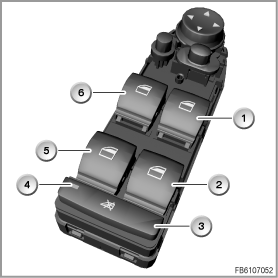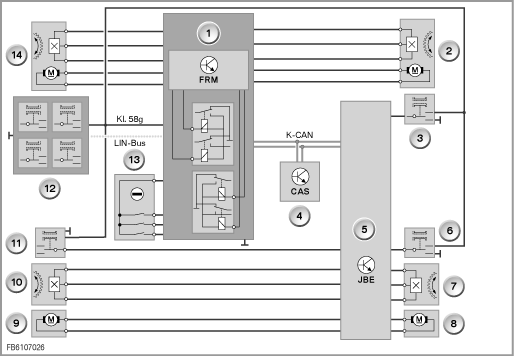
All the power windows in the E70 can be operated from the switch block in the driver's door. The power windows are activated by different control units. The Car Access System (CAS) assumes the central controlling function.
The following components are described for the power windows:
The switch block in the driver's door can be used to operate all the power window functions. The switch block in the driver's door sends its signals across the LIN bus to the footwell module (FRM).
The front-passenger door and the rear doors are equipped with separate power-window switches. The power window of the door on the passenger's side and the power windows of the rear doors send their signals directly to the junction box electronics (JBE).
There is a DC motor in each door which drives the power windows. The power windows are designed as wire lifter drives. There is a Hall sensor in each power-window motor. The direction of rotation, speed and position can be determined through these. The window lifter motor runs at different speeds depending on the window position and operation.
The CAS is connected across the K-CAN with the footwell module (FRM) and the junction box electronics (JBE). The CAS is responsible for the convenience functions of the power windows. All signals to control the power windows are sent by the CAS on the K-CAN.
The FRM processes the signals from the driver's door switch block, JBE and CAS. The FRM electrically activates the front power windows. The FRM is connected via the K-CAN with the CAS and the JBE.
The JBE processes the signals from the power window switches in the doors. The JBE activates the rear power windows electrically. The JBE sends the requests from the power windows on the passenger's side on the K-CAN to the FRM.

Graphic shows the switch block in the driver's door in the E70
Index |
Explanation |
Index |
Explanation |
|---|---|---|---|
1 |
Power-window switches, passenger's side |
2 |
Rear passenger side power windows switch |
3 |
Button for child locks |
4 |
Indicator light for child locks |
5 |
Rear driver's side power windows switch |
6 |
Power windows switch, front driver's side |

Block diagram for R56
Index |
Explanation |
Index |
Explanation |
|---|---|---|---|
1 |
Footwell module (FRM) |
2 |
Power window unit, passenger's side |
3 |
Power-window switches, passenger's side |
4 |
Car Access System (CAS) |
5 |
Junction box electronics (JBE) |
6 |
Rear passenger side power windows switch |
7 |
Hall sensor for power window, passenger's side at rear |
8 |
Power window drive, passenger side rear |
9 |
Power window drive, passenger side rear |
10 |
Hall sensor for power window, driver's side at rear |
11 |
Rear passenger side power windows switch |
12 |
Switch block, driver's door |
13 |
Driver's door lock |
14 |
Power window unit, driver's door |
The following functions are described for the power windows:
The power windows may be operated from terminal R ON. With terminal R Off, the power windows can still be operated for 1 minute. The power windows cannot be operated if one of the front doors is open. The side windows can be opened and closed using the following control units:
This convenience function is controlled by the CAS. The CAS sends the signal for convenience opening or convenience closing on the K-CAN. This signal can be triggered using the remote control or the driver's door lock cylinder. Convenience closing is activated when:
Convenience opening is activated using the same controls as convenience closing. Convenience opening is performed in the following order:
If the activation is interrupted, the convenience function is halted.
The power-window drive runs at higher speed during one-touch opening or closing. One-touch opening/closing is only possible with the anti-trap function activated. To ensure that the side windows are securely closed, the power-window motors are briefly moved to the locked position (mechanical final stop) end in the upper stop.
Emergency closing is for intentional closing of the side windows with the anti-trap function. To do this, the power-window switch must be pressed and held. It might be necessary to use this function in the event of an attack or if the side windows are frozen in place. Emergency closing can be activated at a speed of up to 16 km/h. Letting go of the power window switch interrupts the function.
When the child-proof locks are applied, emergency closing for the rear side doors can only be triggered via the switch block in the driver's door. If emergency closing is triggered for any side window via the switch block in the driver's door: the closing operation can be stopped by the other power window switches unless the childproof locks have been applied.
The panic mode can only be triggered after emergency closing has been performed. If the user releases and then presses and holds the power-window switch within four seconds, the side window is closed without the anti-trap function. The side window is then closed with maximum force and speed. In the event of blocking, the power-window motor is supplied with current until the overheating protection is activated. The side windows can be opened at any time, even if the thermal switch has tripped. Letting go of the power window switch interrupts the function.
The child-proof locks inhibit the function of the rear power-window switch. The child-proof locks are enabled/disabled through a switch on the switch block in the driver's door. When the child-proof locks are enabled, the function LED in the button is switched on. The childproof locks are deactivated in crash mode. The following safety functions are to be observed with the child-proof locks enabled and automatic closing function of the rear power windows in progress:
A repeat lock is provided for each motor to prevent the power-window motors from overheating. The running time for the power-window motor is limited. The motor is switched off for a defined time. The anti-repeat circuit permits at least five complete window movements (OPEN/CLOSE). The last possible movement is always a closing process. If something becomes trapped, the anti-repeat circuit will not prevent opening. The anti-trap circuit always reverses the movement of the side window.
The anti-trap function is active during the entire window movement in the closing direction. The indirect anti-trap function does not in principle prevent trapping; instead, it limits the maximum permissible force applied to the trapped object. The anti-trap function is only enabled once the power windows have been successfully initialised and automatic closing is possible. The mechanical forces for the closing procedure vary according to the ambient temperature and ageing. Consequently, the closing force is relearnt each time the sunroof closes, so that the anti-trap function can adjust accordingly.
To protect the battery, the power windows will not operate while the engine is being started. Every ongoing function of the power windows is halted. If the battery voltage falls below 9 volts, the power-window motors are switched off.
No liability can be accepted for printing or other errors. Subject to changes of a technical nature